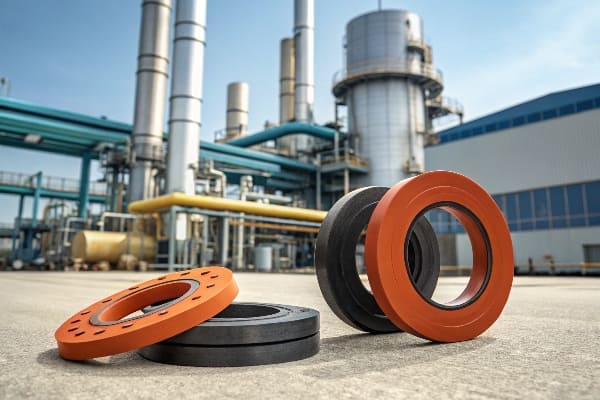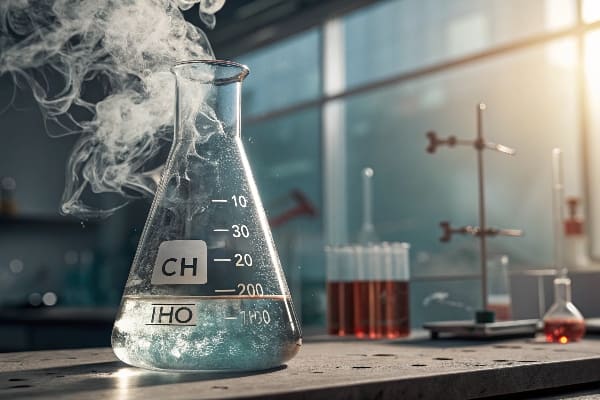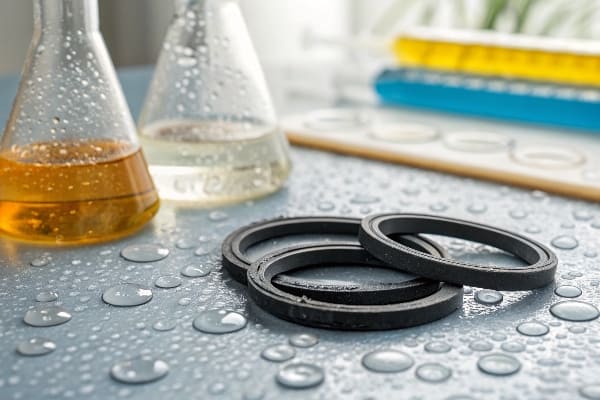When dealing with hydrochloric acid in industrial applications, choosing the right rubber material is crucial. You need a rubber that can withstand the corrosive properties of hydrochloric acid without degrading. Let’s explore the best options.
The best rubber for hydrochloric acid resistance is typically EPDM (Ethylene Propylene Diene Monomer) or viton (FKM). These materials offer excellent chemical resistance, especially against strong acids like hydrochloric acid.

Choosing the right rubber material for hydrochloric acid exposure requires careful consideration of factors like chemical compatibility, temperature resistance, and mechanical properties. Let’s take a deeper look at the most resistant types of rubber for this purpose.
What Is Hydrochloric Acid and Why Is It Dangerous for Rubber?
Are you curious about what makes hydrochloric acid so challenging for rubber materials? Understanding its chemical nature will help in selecting the right rubber to handle this acid.
Hydrochloric acid is a strong and corrosive acid used in various industries, including cleaning and manufacturing. Its reactive nature makes it particularly harsh on certain rubber compounds.

Hydrochloric acid (HCl) is a strong, corrosive acid commonly used in chemical processing, cleaning, and metal production. It can break down many materials, including some rubber compounds, making it essential to select the right rubber for applications where HCl is involved.
When rubber is exposed to hydrochloric acid1, it can weaken and degrade, leading to leaks, cracks, or complete failure of the seals, hoses, or gaskets. The acid can attack the chemical structure of the rubber, causing it to swell, soften, or become brittle.
Rubber materials with higher chemical resistance2 are designed to withstand prolonged exposure to corrosive substances like HCl. The resistance to hydrochloric acid is crucial in industries like the chemical, pharmaceutical, and manufacturing sectors, where rubber components come into direct contact with the acid.
| Rubber Type | Chemical Resistance to HCl | Ideal Applications |
|---|---|---|
| EPDM | Excellent | Seals, hoses, gaskets |
| Viton (FKM) | Very good | Seals, valves, gaskets |
| Nitrile (NBR) | Good, with limitations | Fuel systems, general sealing |
✅ Why it matters:
Selecting the right rubber that resists hydrochloric acid ensures longer-lasting and safer components in industrial environments.
Best Rubber Types for Hydrochloric Acid Resistance
Are you wondering which specific rubber materials are best for withstanding hydrochloric acid? Let’s break down the top contenders for this critical application.
EPDM (Ethylene Propylene Diene Monomer) and Viton (FKM) are the best rubbers for hydrochloric acid resistance. Both offer excellent performance under exposure to HCl.

The two most commonly recommended rubbers for hydrochloric acid resistance are EPDM and Viton (FKM), each offering different benefits based on the application requirements.
1. EPDM3 Rubber
EPDM is an excellent choice for handling hydrochloric acid, especially when the acid is at low to moderate concentrations. EPDM is highly resistant to a wide range of chemicals, including strong acids like HCl, and performs well in both high and low temperatures. Its resistance to oxidation, ozone, and weathering also makes it ideal for outdoor applications.
- Best For: Seals, gaskets, hoses, and industrial equipment exposed to hydrochloric acid in moderate concentrations.
- Limitations: Not suitable for high concentrations of HCl or extremely high temperatures.
2. Viton (FKM)4 Rubber
Viton, a fluoroelastomer, offers superior resistance to hydrochloric acid, even in high concentrations. It also performs exceptionally well at higher temperatures, making it ideal for applications where HCl is present at elevated temperatures. Its strong chemical resistance and low permeability to gases make it perfect for sealing applications in the chemical and pharmaceutical industries.
- Best For: Seals, gaskets, and valves used in high-temperature or highly concentrated hydrochloric acid environments.
- Limitations: More expensive than other rubbers.
3. Nitrile Rubber (NBR)5
Nitrile rubber offers good resistance to hydrochloric acid but is more limited compared to EPDM and Viton. It performs well in fuel and oil applications but is less effective when exposed to strong acids like hydrochloric acid over time. It can be used in applications where acid exposure is intermittent or at lower concentrations.
- Best For: General sealing applications in environments where hydrochloric acid is present in low concentrations.
- Limitations: Not recommended for prolonged or high-concentration HCl exposure.
| Rubber Type | HCl Resistance | Best Application | Temperature Range |
|---|---|---|---|
| EPDM | Excellent | Seals, hoses, gaskets | -50°C to +150°C |
| Viton (FKM) | Very good | High-temp seals, valves | -20°C to +250°C |
| Nitrile (NBR) | Good (with limits) | Fuel systems, general sealing | -30°C to +100°C |
✅ Why it matters:
Choosing the correct rubber based on its resistance to hydrochloric acid ensures long-lasting performance in demanding environments.
How to Choose the Right Rubber for Hydrochloric Acid?
Choosing the right rubber for hydrochloric acid resistance depends on several factors. Let's break down the most important considerations.
Consider factors like acid concentration, temperature, and the specific application when choosing the right rubber for hydrochloric acid exposure. EPDM and Viton are the best choices for most scenarios.
When selecting rubber for hydrochloric acid applications, there are several factors to consider:
- Concentration of Hydrochloric Acid: Higher concentrations of HCl require more resistant materials like Viton (FKM), while moderate concentrations can be handled by EPDM.
- Temperature: For high-temperature environments, Viton rubber is the best choice due to its superior thermal stability.
- Exposure Duration: If rubber will be exposed to HCl for extended periods, select materials with the best chemical resistance to ensure long-term durability.
- Application Type: Seals, hoses, gaskets, and valves all have different requirements based on the type of exposure to hydrochloric acid, so choose the material that provides the best combination of resistance and flexibility for each case.
Key Factors to Consider When Choosing Rubber for Hydrochloric Acid:
| Factor | Best Rubber Choices | Key Considerations |
|---|---|---|
| Acid Concentration | EPDM, Viton (FKM) | Higher concentrations need Viton |
| Temperature | Viton (FKM), EPDM | Viton for high temperature tolerance |
| Exposure Duration | EPDM, Viton (FKM) | Longer exposure needs more resistant materials |
| Application Type | EPDM, Viton (FKM), Nitrile | Select rubber type based on specific application |
✅ Why it matters:
By carefully selecting the right rubber material based on these factors, you can ensure reliable performance and safety when using rubber components exposed to hydrochloric acid.
Conclusion
When dealing with hydrochloric acid, choosing the right rubber material is essential for ensuring durability and performance in harsh environments. EPDM and Viton are the best options, with EPDM suitable for moderate concentrations and Viton for high concentrations and elevated temperatures. Consider the acid concentration, temperature, and specific application to make the right selection for your needs.
🚀 Need Custom Rubber Solutions for Your Industrial Needs?
Contact Julong Rubber today or Request a Custom Quote for high-quality rubber components tailored to your specifications!
Or reach out to us directly via WhatsApp:
Understanding hydrochloric acid's properties can help you choose the right materials for safety and efficiency in industrial processes. ↩
Exploring chemical resistance helps ensure the right materials are used, preventing failures and enhancing safety in various industries. ↩
Explore the advantages of EPDM rubber for hydrochloric acid applications, including its chemical resistance and temperature performance. ↩
Learn about Viton (FKM) rubber's superior resistance to hydrochloric acid, especially in high-temperature applications. ↩
Discover the limitations and applications of Nitrile Rubber (NBR) in hydrochloric acid environments for better material selection. ↩








